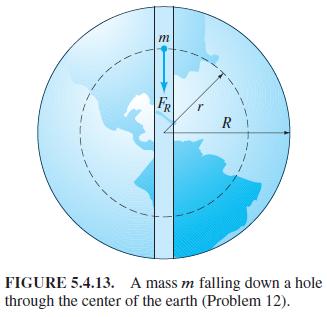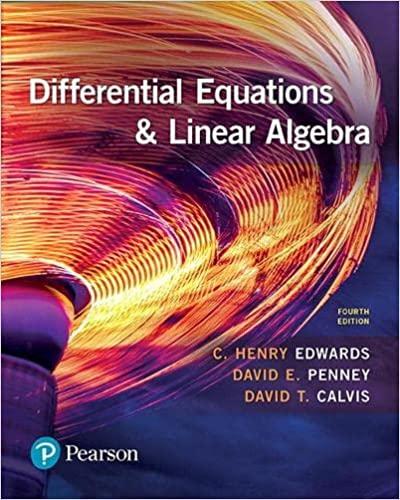Assume that the earth is a solid sphere of uniform density, with mass M and radius R
Question:
Assume that the earth is a solid sphere of uniform density, with mass M and radius R = 3960 (mi). For a particle of mass m within the earth at distance r from the center of the earth, the gravitational force attracting m toward the center is Fr = -GMrm/r2, where Mr is the mass of the part of the earth within a sphere of radius r (Fig. 5.4.13).
(a) Show that Fr = -GMmr/R3.
(b) Now suppose that a small hole is drilled straight through the center of the earth, thus connecting two antipodal points on its surface. Let a particle of mass m be dropped at time t = 0 into this hole with initial speed zero, and let r(t) be its distance from the center of the earth at time t , where we take r < 0 when the mass is “below” the center of the earth. Conclude from New-ton’s second law and part (a) that r'' (t) = -k2r(t), where k2 = GM/R3 = g/R.
(c) Take g = 32.2 ft/s2, and conclude from part (b) that the particle undergoes simple harmonic motion back and forth between the ends of the hole, with a period of about 84 min.
(d) Look up (or derive) the period of a satellite that just skims the surface of the earth; compare with the result in part (c). How do you explain the coincidence? Or is it a coincidence?
(e) With what speed (in miles per hour) does the particle pass through the center of the earth?
(f) Look up (or derive) the orbital velocity of a satellite that just skims the surface of the earth; compare with the result in part (e). How do you explain the coincidence? Or is it a coincidence?

Step by Step Answer:

Differential Equations And Linear Algebra
ISBN: 9780134497181
4th Edition
Authors: C. Edwards, David Penney, David Calvis





